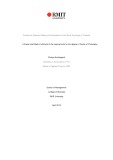
TNU Journal of Science and Technology
230(03): 78 - 85
http://jst.tnu.edu.vn 78 Email: jst@tnu.edu.vn
GEOPOLITICAL UNCERTAINTY: SECTORAL DYNAMICS
IN VIETNAM’S OUTWARD FOREIGN DIRECT INVESTMENT
Vu Thi Phuong Mai*, Tran Anh Ngoc, Hoang Ngoc Linh, Phung Thi Lan Huong, Le Mai Phuong
Foreign Trade University
ARTICLE INFO
ABSTRACT
Received:
19/12/2024
This study investigates the impact of geopolitical risks on Vietnamese
outward foreign direct investment at the sectoral level during the
period from 2010 to 2022. The analysis employs a Least square dummy
variable regression model. The findings reveal that domestic
geopolitical risks tend to increase Vietnamese outward foreign direct
investment, while global geopolitical risks- particularly those
associated with the United States and China- exert a negative
influence. The contributions of this research are threefold: (i)
examining the effects of geopolitical uncertainty on outward foreign
direct investment at the sectoral level; (ii) highlighting the influence of
geopolitical risks originating from major global powers, such as China
and the United States, on Vietnam's economic dynamics; and (iii)
providing new insights and practical policy recommendations to
enhance the effectiveness of Vietnamese outward foreign direct
investment strategies amid rising global uncertainty.
Revised:
27/3/2025
Published:
28/3/2025
KEYWORDS
Geopolitical Risk
Outward Foreign Direct
Investment
Investment decision
Vietnam
Least square dummy variable
regression model
ẢNH HƯỞNG CỦA RỦI RO ĐỊA CHÍNH TRỊ TỚI DÒNG VỐN ĐẦU TƯ
TRỰC TIẾP RA NƯỚC NGOÀI CỦA VIỆT NAM:
PHÂN TÍCH THỰC NGHIỆM TỪ CẤP ĐỘ NGÀNH
V Th Phương Mai*, Trn nh Ngc, Hong Ngc Linh, Phng Th Lan Hương, Lê Mai Phương
Trường Đại học Ngoại thương
THÔNG TIN BÀI BÁO
TÓM TẮT
Ngày nhận bài:
19/12/2024
Nghiên cứu này phân tích tác động của rủi ro địa chính trị tới dòng
vốn đầu tư trực tiếp ra nước ngoài của Việt Nam ở cấp độ ngành trong
giai đoạn từ năm 2010 đến năm 2022. Phương pháp hồi quy sử dụng
trong nghiên cứu là mô hình bình phương tối thiểu với biến giả. Kết
quả cho thấy rủi ro địa chính trị trong nước có xu hướng làm tăng dòng
vốn đầu tư trực tiếp ra nước ngoài của Việt Nam, trong khi các rủi ro
địa chính trị toàn cầu- đặc biệt là từ Hoa Kỳ và Trung Quốc- lại tác
động tiêu cực tới hoạt động này. Nghiên cứu đóng góp vào lĩnh vực
theo ba khía cạnh chính: (i) phân tích tác động của bất định địa chính
trị đối với đầu tư trực tiếp ra nước ngoài ở cấp ngành; (ii) làm rõ ảnh
hưởng của rủi ro địa chính trị từ các cường quốc như Trung Quốc và
Hoa Kỳ đến các khía cạnh khác nhau của nền kinh tế Việt Nam; và
(iii) cung cấp những góc nhìn mới cùng các khuyến nghị chính sách
thiết thực nhằm nâng cao hiệu quả chiến lược đầu tư trực tiếp ra nước
ngoài của Việt Nam trong bối cảnh bất ổn toàn cầu gia tăng.
Ngày hoàn thiện:
27/3/2025
Ngy đăng:
28/3/2025
TỪ KHÓA
Rủi ro địa chính trị
Đầu tư trực tiếp ra nước ngoài
Quyết định đầu tư
Việt Nam
Mô hình bình phương tối thiểu với
biến giả
DOI: https://doi.org/10.34238/tnu-jst.11745
* Corresponding author. Email: maivp@ftu.edu.vn













